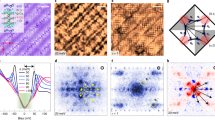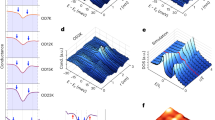Abstract
In conventional metallic superconductors such as aluminium, the large number of weakly bounded Cooper pairs become phase-coherent as soon as they start to form. The cuprate high-temperature superconductors belong to a different category because, being doped Mott insulators, they are known to have low superfluid density and are therefore susceptible to phase fluctuations. It has been proposed that pairing and phase coherence may occur separately in cuprates, and that the measured critical temperature corresponds to the phase-coherence temperature controlled by the superfluid density. Here we examine the evolution of pairing and phase-ordering in underdoped cuprates, and find that a chequerboard plaquette pattern of charge order plays a crucial role, such that the global phase coherence is established once its spatial occupation exceeds a threshold. We make these observations via scanning tunnelling microscopy on underdoped Bi2LaxSr2 − xCuO6 + δ. We observe a smooth crossover from the Mott insulator to superconductor on small islands that have chequerboard order. Each chequerboard plaquette contains approximately two holes and exhibits a stripy internal structure that has a strong influence on the superconducting spectroscopic features. The local spectra remain qualitatively the same across the insulator-to-superconductor transition, and the quasiparticle interference becomes long-ranged.
This is a preview of subscription content, access via your institution
Access options
Access Nature and 54 other Nature Portfolio journals
Get Nature+, our best-value online-access subscription
$29.99 / 30 days
cancel any time
Subscribe to this journal
Receive 12 print issues and online access
$209.00 per year
only $17.42 per issue
Buy this article
- Purchase on Springer Link
- Instant access to full article PDF
Prices may be subject to local taxes which are calculated during checkout





Similar content being viewed by others

Data availability
Data are available from the corresponding author upon reasonable request. Source data are provided with this paper.
References
Lee, P. A., Nagaosa, N. & Wen, X.-G. Doping a Mott insulator: physics of high-temperature superconductivity. Rev. Mod. Phys. 78, 17–85 (2006).
Emery, V. & Kivelson, S. Importance of phase fluctuations in superconductors with small superfluid density. Nature 374, 434–437 (1995).
Uemura, Y. et al. Universal correlations between Tc and ns/m* (carrier density over effective mass) in high-Tc cuprate superconductors. Phys. Rev. Lett. 62, 2317–2320 (1989).
Homes, C. et al. A universal scaling relation in high-temperature superconductors. Nature 430, 539–541 (2004).
Bozovic, I., He, X., Wu, J. & Bollinger, A. T. Dependence of the critical temperature in overdoped copper oxides on superfluid density. Nature 536, 309–311 (2016).
Corson, J., Mallozzi, R., Orenstein, J., Eckstein, J. & Bozovic, I. Vanishing of phase coherence in underdoped Bi2Sr2CaCu2O8 + δ. Nature 398, 221–223 (1999).
Wang, Y. et al. Field-enhanced diamagnetism in the pseudogap state of the cuprate Bi2Sr2CaCu2O8 + δ superconductor in an intense magnetic field. Phys. Rev. Lett. 95, 247002 (2005).
Li, L., Checkelsky, J., Komiya, S., Ando, Y. & Ong, N. Low-temperature vortex liquid in La2 − xSrxCuO4. Nat. Phys. 3, 311–314 (2007).
Lee, J. et al. Spectroscopic fingerprint of phase-incoherent superconductivity in the underdoped Bi2Sr2CaCu2O8 + δ. Science 325, 1099–1103 (2009).
Kohsaka, Y. et al. How Cooper pairs vanish approaching the Mott insulator in Bi2Sr2CaCu2O8 + δ. Nature 454, 1072–1078 (2008).
Gomes, K. K. et al. Visualizing pair formation on the atomic scale in the high-Tc superconductor Bi2Sr2CaCu2O8 + δ. Nature 447, 569–572 (2007).
Pasupathy, A. N. et al. Electronic origin of the inhomogeneous pairing interaction in the high-Tc superconductor Bi2Sr2CaCu2O8 + δ. Science 320, 196–201 (2008).
Kugler, M., Fischer, O., Renner, C., Ono, S. & Ando, Y. Scanning tunneling spectroscopy of Bi2Sr2CuO6 + δ: new evidence for the common origin of the pseudogap and superconductivity. Phys. Rev. Lett. 86, 4911–4914 (2001).
Loeser, A. et al. Excitation gap in the normal state of underdoped Bi2Sr2CaCu2O8 + δ. Science 273, 325–329 (1996).
Ding, H. et al. Spectroscopic evidence for a pseudogap in the normal state of underdoped high-Tc superconductors. Nature 382, 51–54 (1996).
Peng, Y. et al. Disappearance of nodal gap across the insulator–superconductor transition in a copper-oxide superconductor. Nat. Commun. 4, 2459 (2013).
Ando, Y. et al. Metallic in-plane and divergent out-of-plane resistivity of a high-Tc cuprate in the zero-temperature limit. Phys. Rev. Lett. 77, 2065–2068 (1996).
Ando, Y. et al. Normal-state Hall effect and the insulating resistivity of high-Tc cuprates at low temperatures. Phys. Rev. B 56, R8530–R8533 (1997).
Fischer, Ø., Kugler, M., Maggio-Aprile, I., Berthod, C. & Renner, C. Scanning tunneling spectroscopy of high-temperature superconductors. Rev. Mod. Phys. 79, 353–419 (2007).
Yu, Y. et al. High-temperature superconductivity in monolayer Bi2Sr2CaCu2O8 + δ. Nature 575, 156–163 (2019).
Anderson, P. W. & Ong, N. P. Theory of asymmetric tunneling in the cuprate superconductors. J. Phys. Chem. Solids 67, 1–5 (2006).
Kohsaka, Y. et al. Visualization of the emergence of the pseudogap state and the evolution to superconductivity in a lightly hole-doped Mott insulator. Nat. Phys. 8, 534–538 (2012).
Cai, P. et al. Visualizing the evolution from the Mott insulator to a charge-ordered insulator in lightly doped cuprates. Nat. Phys. 12, 1047–1051 (2016).
Emery, V. J., Kivelson, S. A. & Lin, H. Q. Phase separation in the t-J model. Phys. Rev. Lett. 64, 475–478 (1990).
Battisti, I. et al. Universality of pseudogap and emergent order in lightly doped Mott insulators. Nat. Phys. 13, 21–25 (2016).
Ruan, W. et al. Visualization of the periodic modulation of Cooper pairing in a cuprate superconductor. Nat. Phys. 14, 1178–1182 (2018).
Li, X. et al. Evolution of charge and pair density modulations in overdoped Bi2Sr2CuO6 + δ. Phys. Rev. X 11, 011007 (2021).
Chatterjee, U. et al. Observation of a d-wave nodal liquid in highly underdoped Bi2Sr2CaCu2O8 + δ. Nat. Phys. 6, 99–103 (2009).
Doiron-Leyraud, N. et al. Onset of a Boson mode at the superconducting critical point of underdoped YBa2Cu3Oy. Phys. Rev. Lett. 97, 207001 (2006).
Shi, X. et al. Emergence of superconductivity from the dynamically heterogeneous insulating state in La2 − xSrxCuO4. Nat. Mater. 12, 47–51 (2013).
Peng, Y. Y. et al. Direct observation of charge order in underdoped and optimally doped Bi2(Sr, La)2CuO6 + δ by resonant inelastic X-ray scattering. Phys. Rev. B 94, 184511 (2016).
Comin, R. et al. Charge order driven by Fermi-arc instability in Bi2Sr2 − xLaxCuO6 + δ. Science 343, 390–392 (2014).
Wise, W. et al. Charge-density-wave origin of cuprate checkerboard visualized by scanning tunnelling microscopy. Nat. Phys. 4, 696–699 (2008).
Webb, T. A. et al. Density wave probes cuprate quantum phase transition. Phys. Rev. X 9, 021021 (2019).
Hanaguri, T. et al. Quasiparticle interference and superconducting gap in Ca2 − xNaxCuO2Cl2. Nat. Phys. 3, 865–871 (2007).
Wang, Q.-H. & Lee, D.-H. Quasiparticle scattering interference in high-temperature superconductors. Phys. Rev. B 67, 020511 (2003).
Hoffman, J. et al. Imaging quasiparticle interference in Bi2Sr2CaCu2O8 + δ. Science 297, 1148–1151 (2002).
Hanaguri, T. et al. Coherence factors in a high-Tc cuprate probed by quasi-particle scattering off vortices. Science 323, 923–926 (2009).
Fujita, K. et al. Bogoliubov angle and visualization of particle-hole mixture in superconductors. Phys. Rev. B 78, 054510 (2008).
Chubukov, A. V., Norman, M. R., Millis, A. J. & Abrahams, E. Gapless pairing and the Fermi arc in the cuprates. Phys. Rev. B 76, 180501 (2007).
Wulin, D., He, Y., Chien, C.-C., Morr, D. K. & Levin, K. Model for the temperature dependence of the quasiparticle interference pattern in the measured scanning tunneling spectra of underdoped cuprate superconductors. Phys. Rev. B 80, 134504 (2009).
Imry, Y. & Strongin, M. Destruction of superconductivity in granular and highly disordered metals. Phys. Rev. B 24, 6353–6360 (1981).
Imry, Y., Strongin, M. & Homes, C. ns−Tc correlations in granular superconductors. Phys. Rev. Lett. 109, 067003 (2012).
Imry, Y., Strongin, M. & Homes, C. An inhomogeneous Josephson phase in thin-film and high-Tc superconductors. J. Phys. C Superconductivity 468, 288–293 (2008).
Zuev, Y., Kim, M. S. & Lemberger, T. R. Correlation between superfluid density and Tc of underdoped YBa2Cu3O6 + x near the superconductor-insulator transition. Phys. Rev. Lett. 95, 137002 (2005).
Haviland, D., Liu, Y. & Goldman, A. Onset of superconductivity in the two-dimensional limit. Phys. Rev. Lett. 62, 2180–2183 (1989).
Yazdani, A. & Kapitulnik, A. Superconducting-insulating transition in two-dimensional α-MoGe thin films. Phys. Rev. Lett. 74, 3037–3040 (1995).
Mason, N. & Kapitulnik, A. Dissipation effects on the superconductor-insulator transition in 2D superconductors. Phys. Rev. Lett. 82, 5341–5344 (1999).
Zaanen, J. & Gunnarsson, O. Charged magnetic domain lines and the magnetism of high-Tc oxides. Phys. Rev. B 40, 7391–7394 (1989).
Tranquada, J., Sternlieb, B., Axe, J., Nakamura, Y. & Uchida, S. Evidence for stripe correlations of spins and holes in copper oxide superconductors. Nature 375, 561–563 (1995).
Kivelson, S. A., Fradkin, E. & Emery, V. J. Electronic liquid-crystal phases of a doped Mott insulator. Nature 393, 550–553 (1998).
Tranquada, J. M., Dean, M. P. & Li, Q. Superconductivity from charge order in cuprates. J. Phys. Soc. Jpn 90, 111002 (2021).
Jiang, H.-C. & Kivelson, S. A. Stripe order enhanced superconductivity in the Hubbard model. Proc. Natl Acad. Sci. USA 119, e2109406119 (2022).
Zhao, J.-Y., Chen, S. A., Zhang, H.-K. & Weng, Z.-Y. Two-hole ground state: dichotomy in pairing symmetry. Phys. Rev. X 12, 011062 (2022).
Lawler, M. J. et al. Intra-unit-cell electronic nematicity of the high-Tc copper-oxide pseudogap states. Nature 466, 347–351 (2010).
Acknowledgements
We thank Z.Y. Weng, G.M. Zhang and C.L. Song for helpful discussions and technical support. This work is supported by the Basic Science Center Project of NSFC (grant no. 52388201), the Innovation Program for Quantum Science and Technology (grant no. 2021ZD0302502), NSFC grant no. 11888101 and the Strategic Priority Research Program (B) of the Chinese Academy of Sciences (XDB25000000). Yayu Wang is supported by the New Cornerstone Science Foundation through the New Cornerstone Investigator Program and the XPLORER PRIZE.
Author information
Authors and Affiliations
Contributions
Y.W. and X.Z. supervised the project. H.Y. and Y.C. prepared the single crystal. S.Y., C.Z. and M.X. carried out the STM experiments under the supervision of Y.W. Z.D., Y.J. and S.Y. performed the transport experiments. S.Y. and Y.W. prepared the manuscript, with comments from all authors.
Corresponding author
Ethics declarations
Competing interests
The authors declare no competing interests.
Peer review
Peer review information
Nature Physics thanks the anonymous reviewers for their contribution to the peer review of this work.
Additional information
Publisher’s note Springer Nature remains neutral with regard to jurisdictional claims in published maps and institutional affiliations.
Supplementary information
Supplementary Information
Supplementary sections 1–12 and Figs. 1–15.
Source data
Source Data Fig. 1
Temperature dependent resistance curve and spatially averaged spectra of three samples.
Source Data Fig. 2
Linecut spectra, alpha cluster analysis and corresponding 2nd derivative curves of three samples.
Source Data Fig. 3
Linecut spectra of p = 0.08 and p = 0.11 samples.
Source Data Fig. 5
Extracted QPI wavevectors of the three samples in Fig. 5a,b.
Rights and permissions
Springer Nature or its licensor (e.g. a society or other partner) holds exclusive rights to this article under a publishing agreement with the author(s) or other rightsholder(s); author self-archiving of the accepted manuscript version of this article is solely governed by the terms of such publishing agreement and applicable law.
About this article
Cite this article
Ye, S., Zou, C., Yan, H. et al. The emergence of global phase coherence from local pairing in underdoped cuprates. Nat. Phys. 19, 1301–1307 (2023). https://doi.org/10.1038/s41567-023-02100-9
Received:
Accepted:
Published:
Issue Date:
DOI: https://doi.org/10.1038/s41567-023-02100-9


